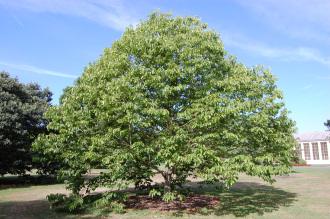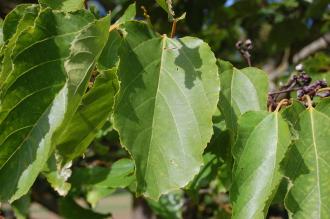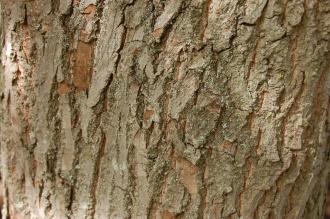
Hovenia dulcis (15/08/2015, Kew Gardens, London)
Position: Full sun to light shade
Flowering period: Early summer
Soil: Moist, well drained
Eventual Height: 10m
Eventual Spread: 7m
Hardiness: 5a, 5b, 6a, 6b, 7a, 7b, 8a, 8b, 9a, 9b
Family: Rhamnaceae
Hovenia dulcis is a deciduous tree with a rounded habit. Its glossy mid green leaves are ovate with irregular serrate margins, up to 17cm long and 11cm across. Its light brown/ orange bark is vertically fissure. Its fragrant hermaphrodite yellow/ green flowers are up to 8mm across, appear in small terminal clusters. Its black fruit is a three seeded nut, up to 8mm across and is edible.

Hovenia dulcis Leaf (15/08/2015, Kew Gardens, London)
Hovenia dulcis, commonly known as Japanes Raisin Tree or Oriental Raisin Tree, is native to east China, and Korea. In it native habitat it grows moist sandy and loamy soils in secondary forests. This tree is considered an invasive species in parts of Brazil.
The etymological root of the binomial name Hovenia is named after David Hoven, an 18th century Dutch missionary. Dulcis is from the Latin meaning ‘sweet’.
The landscape architect may find Hovenia dulcis useful as a small tree suitable for community gardens which produced edible fruit.

Hovenia dulcis Bark (15/08/2015, Kew Gardens, London)
Ecologically, Hovenia dulcis flowers are attractive to pollinating insects. Its fruit is attractive to birds and mammals.
Hovenia dulcis prefers moist, sandy to loamy, well-drained soils. It tolerates most pH of soil.
Hovenia dulcis requires little maintenance.

Landscape Architecture

